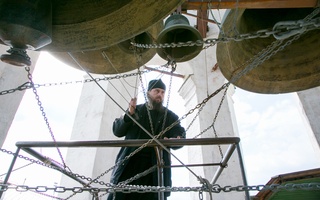Just a few metro stops from Moscow’s Red Square, the quiet stillness of Danilov’s bell tower makes the monastery seem far removed from the frenetic, modern city that has grown up around it—and the political and cultural revolutions of the past 100 years that have transformed Russia from a centuries-old monarchy to a Communist dictatorship to a free market democracy.
But behind its 14th century walls, the monastery—and its bell tower—have been constantly ripped apart and pieced back together through these transitions.
The tower has been rebuilt from scratch since its destruction by the Soviets and an amalgam of substitute bells hang from its rafters.
Despite the structural changes, the Russian Orthodox tradition remains.
Father Roman steadily climbs up the narrow stone stairs within the wall of the bell tower.
Father Roman is used to feeling his shoulders brush against the stucco walls in this quick, but steep climb. He is in charge of a group of several monks that operate the bells on an everyday basis as well as more elaborate orchestras on holidays.
When the monastery was allowed to begin operating again, the monks began searching for bells to fill the restored tower. Hanging from a system of pedals, wheels, ropes, hooks and girdles in the tower is a mix of bells gathered from churches in several Russian districts.
On regular days at the monastery, Father Roman uses a rope at the foot of the tower to ring the “everyday” bell four times per day to signal the beginning and end of the morning and evening church services.
But on holidays like Easter or Christmas, three or four monks operate the bells, with Father Roman dictating the tempo from the platform of pedals and ropes.
“To ring the bells is an expression of prayer,” Father Roman says, explaining that some Orthodox Russians immediately make the sign of the cross when they hear bells ringing. “They’re born from the archangel. The bells are the symbol of that music that will sound gathering people in the face of God.”
The largest holiday bell, used only on the most important Russian Orthodox holidays, hangs in the center of the tower. There is extra room in the tower, Father Roman explains, because it was rebuilt to fit the largest bell—now hanging in Lowell House—which is three times bigger than the one at the monastery.
Eight smaller “guardian” bells hang at the side of the tower.
He carefully demonstrates how the rhythm of the ringing comes from a series of four wooden pedals. As he shifts his weight back and forth and pulls gently at the strings attached to their tongues, the bells let out a soft clanging ring.
“To make your ringing a piece of art, it takes years, as with every art,” he says.
The melody comes from the rhythm that the bell-ringer chooses, he says, adding that he mostly follows the traditional style.
Read more in News
Court Rules Calif. Recall Can ProceedRecommended Articles
-
Our House, Our BellsThe Russians are mad at Harvard again. But this time, instead of faculty bungling their economy, it’s an alum pilfering
-
Lowell House Bells Toll To Commemorate Saint's DeathLowell House attempted to share their coveted bells in spirit—if not in kind—with their original owner in a noontime ceremony
-
Visa Troubles Keep Monks From Visiting Lowell BellsVisa problems prevented a delegation of Muscovite monks from coming to Harvard this weekend on a quest to reclaim their
-
Russian Monks To Visit, Seeking Return of Lowell BellsA delegation of monks from Moscow’s Danilov Monastery—including the spiritual leader of the Russian Orthodox Church—is due to arrive in
-
 For Whom the Bell Tolls
For Whom the Bell Tolls













